Microsoft To Do is an intuitive task management app integrated into Windows 11, designed to help you organize your personal and professional life. Whether you're planning your day, setting reminders, or managing tasks across devices, Microsoft To Do offers a seamless experience. This guide will walk you through setting up and effectively using Microsoft To Do on your Windows 11 computer.
Set Up Microsoft To Do on Windows 11
Microsoft To Do comes pre-installed on Windows 11, making it readily accessible without the need for additional downloads. It synchronizes tasks across devices when you're signed in with your Microsoft account. Here's how to get started:
Step 1: Click on the Start menu and select To Do from the pinned apps. If it's not visible, type To Do in the search bar and open the app from the results.

Step 2: Upon opening the app for the first time, click on the Sign in button and enter your Microsoft account credentials to log in.
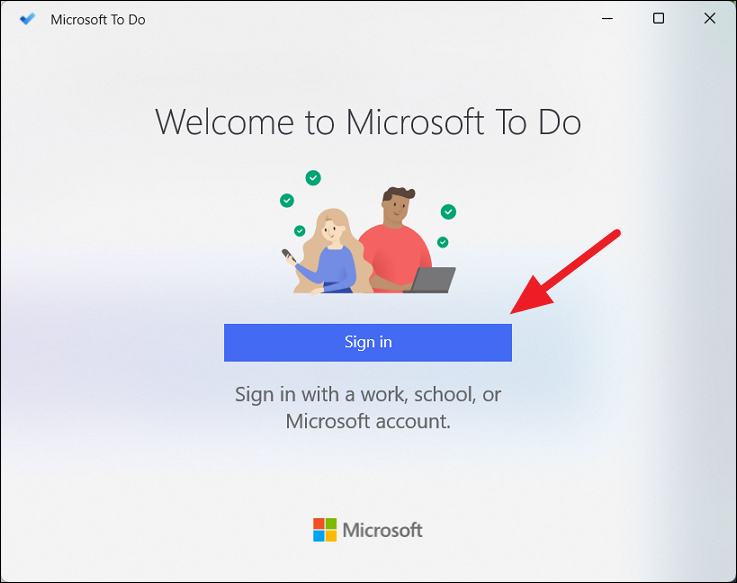
Step 3: The app may prompt you to pin it to the taskbar for quick access. Click Yes if you wish to do so.
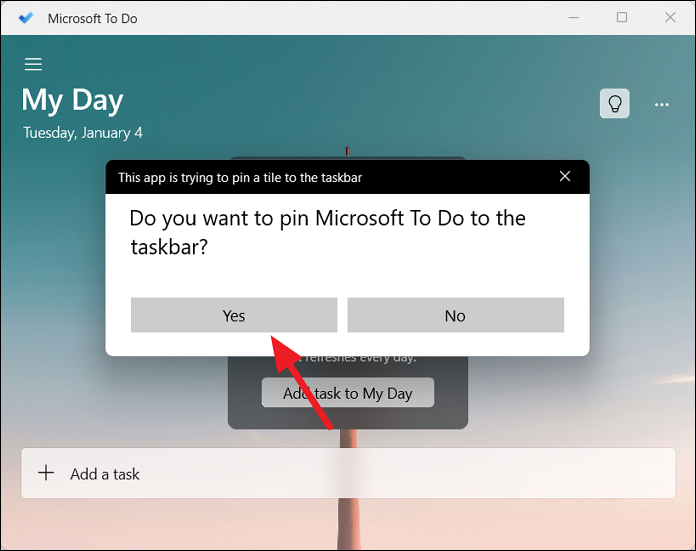
After signing in, you'll see various categories like My Day, Planned, Important, Assigned to you, and Tasks on the left sidebar. These categories, known as smart lists, help you organize and manage your tasks efficiently.

Understanding Smart Lists in Microsoft To Do
Smart lists categorize your tasks, making it easier to prioritize and manage them. Here's what each smart list represents:
- My Day: Tasks you plan to accomplish today. Tasks here reset daily, providing a fresh start each day.
- Important: Tasks you've marked as important with a star. These tasks are crucial and need your attention.
- Planned: Contains tasks with assigned due dates, helping you keep track of upcoming deadlines.
- Assigned to you: Tasks assigned to you from shared lists or Microsoft Planner.
- Tasks: A collection of all your tasks that aren't categorized under other lists.
- Groceries: A specialized list for managing your grocery shopping items.
Creating Tasks in Microsoft To Do
Adding tasks to Microsoft To Do is straightforward. Follow these steps to create and manage your tasks:
Step 1: Navigate to the Tasks tab or any other list where you want to add a task.
Step 2: Click on the Add a task field and type your task description. For example, enter "Take out the trash tomorrow."

Step 3: Before pressing Enter, you can set a reminder, due date, or repeat schedule using the icons next to the task field. Alternatively, press Enter to add the task and modify details later.
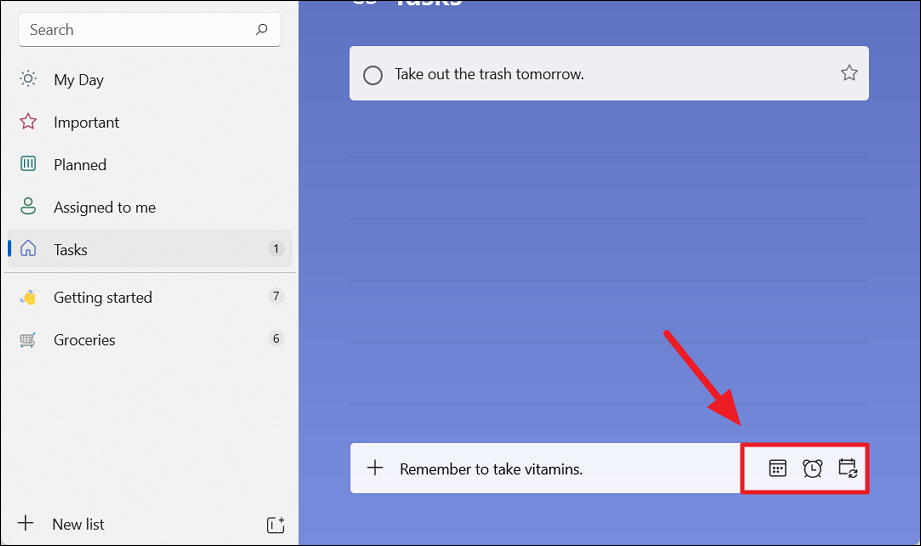
Step 4: To set a reminder, click the Remind me icon and choose a preset option or select Pick a date and time to customize it.

After adding your tasks, you can further refine them by adding steps, setting due dates, and organizing them into lists.
Adding Steps or Subtasks
To break down a task into smaller, manageable parts, you can add steps:
Step 1: Click on the task to open its detail view.
Step 2: Click on Add step and enter the subtask. Press Enter to add more steps as needed.
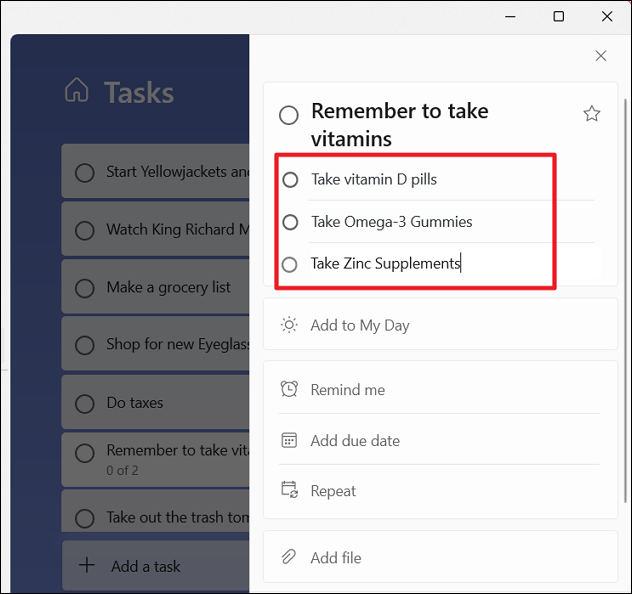
Setting a Reminder
Reminders ensure you don't forget your tasks:
Step 1: In the task's detail view, click on Remind me.
Step 2: Choose a preset reminder or click Pick a date & time to set a custom reminder.

Adding a Due Date
Assigning due dates helps prioritize tasks:
Step 1: Click on Add due date in the task's detail view.
Step 2: Select a preset option or click Pick a date to choose a specific date.

Tasks with due dates automatically appear in the Planned list.
Setting Up a Repeat Schedule
For recurring tasks, establish a repeat schedule:
Step 1: Click on Repeat in the task's detail view.
Step 2: Choose a repetition frequency like Daily, Weekly, or select Custom to define your own schedule.

Step 3: If you selected Custom, specify the interval and days, then click Save.

Add Attachments to Tasks
You can attach files to tasks for additional context:
Step 1: In the task's detail view, click on Add file.

Step 2: Browse and select the file from your computer, then click Open.
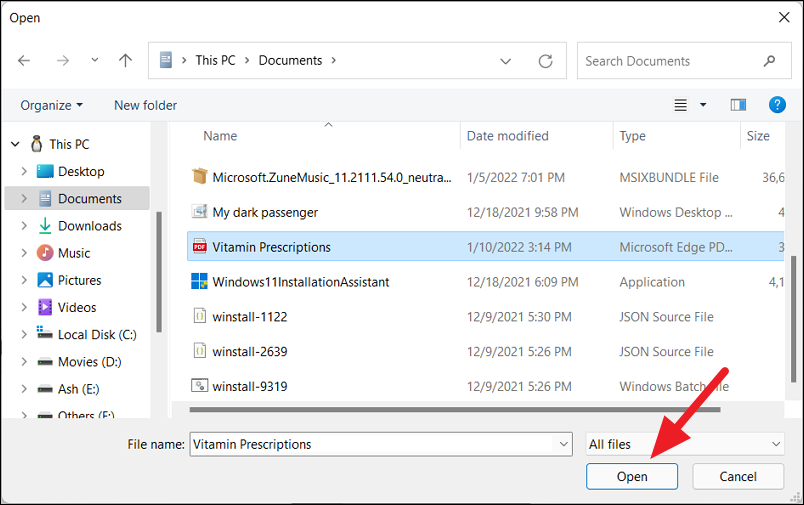
You can also add notes in the Add note section for additional details.
Create Tasks with Cortana
Microsoft To Do integrates with Cortana, allowing you to add tasks using voice commands:
Step 1: Ensure Cortana has access to your microphone. Go to Settings > Privacy & security > Microphone and enable Microphone access and Let apps access your microphone. Then, turn on the toggle for Cortana.
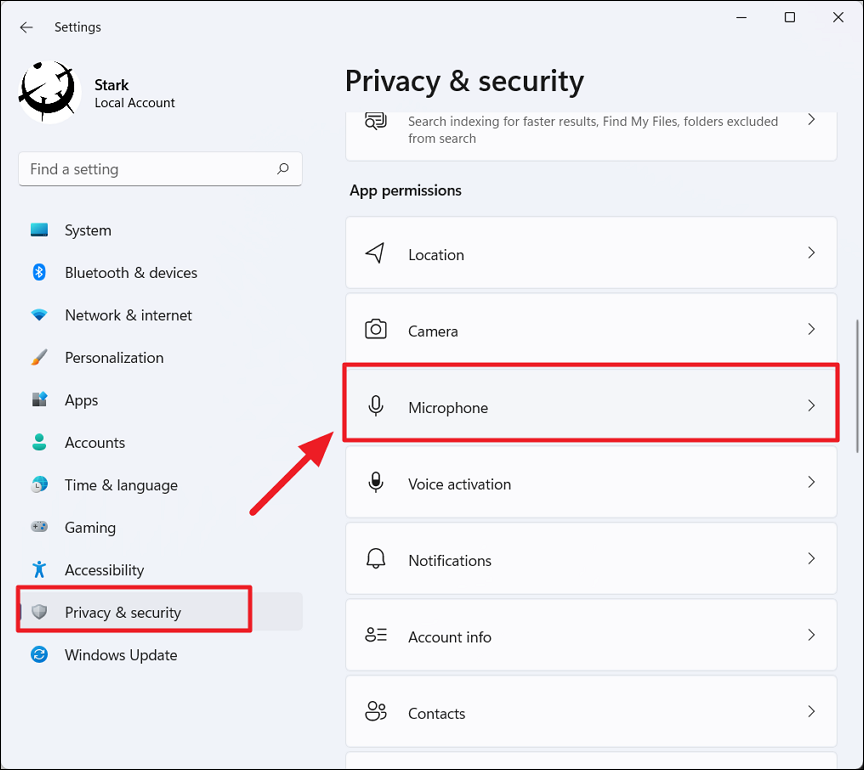
Step 2: Activate Cortana by saying "Hey Cortana."
Step 3: Once Cortana is listening, give a command like "Add 'Prepare presentation for tomorrow's meeting'" or "Remind me to attend the archery session on Monday at 5 P.M."
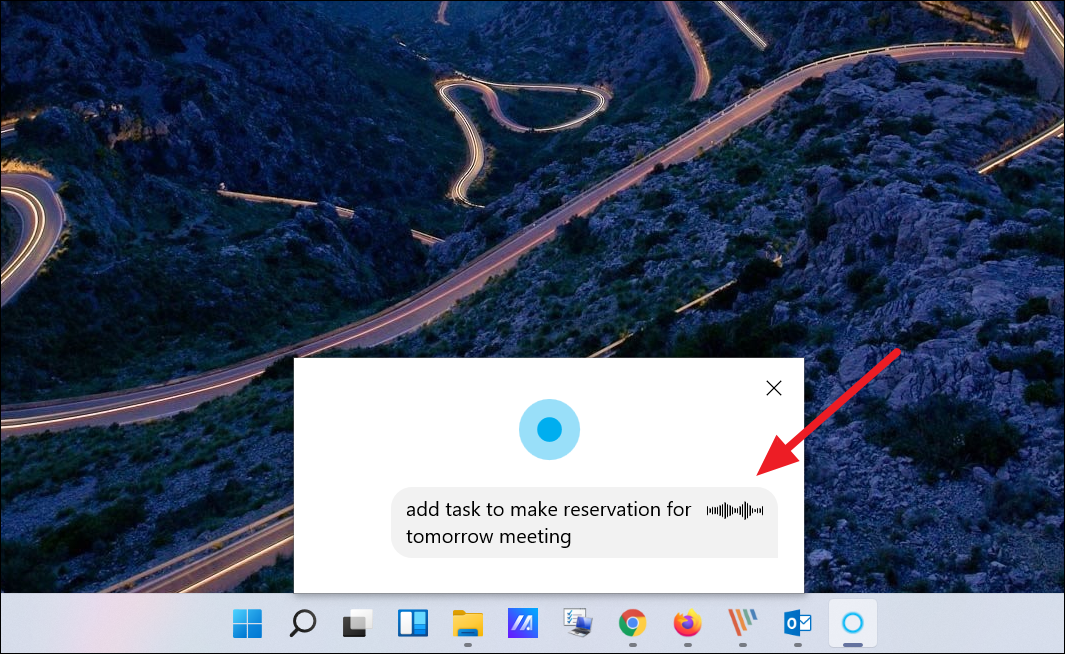
Cortana will recognize the command and add the task to your Microsoft To Do app.
Create a List in Microsoft To Do
Organizing tasks into lists can enhance productivity. Here's how to create a new list:
Step 1: Click on the New list button at the bottom left corner or press Ctrl+L.
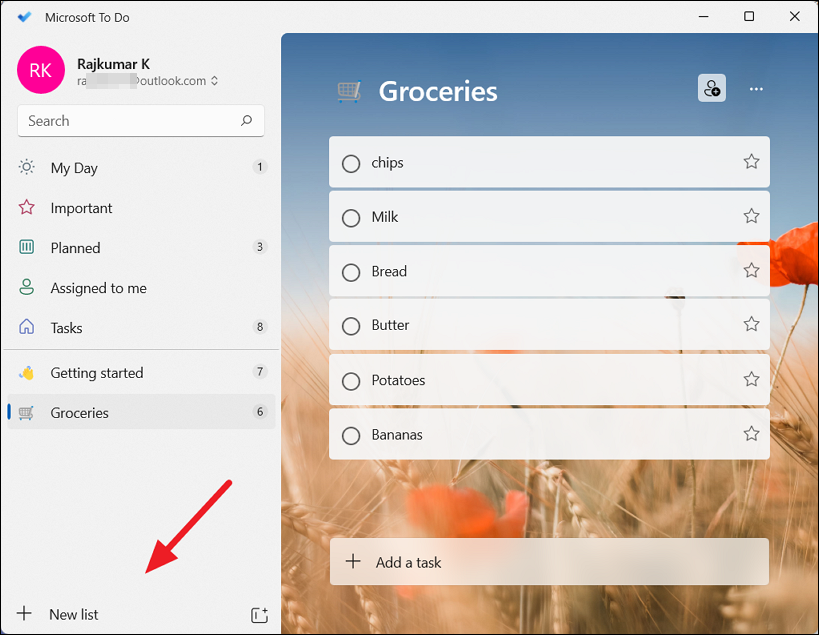
Step 2: A new list named "Untitled list" will appear. Rename it by typing a new name and pressing Enter.

Step 3: Start adding tasks to your new list by typing in the Add a task field.
Create Groups in Microsoft To Do
Groups help you manage multiple lists by categorizing them under a common theme:
Step 1: Click on the Create a new group button next to the New list button.
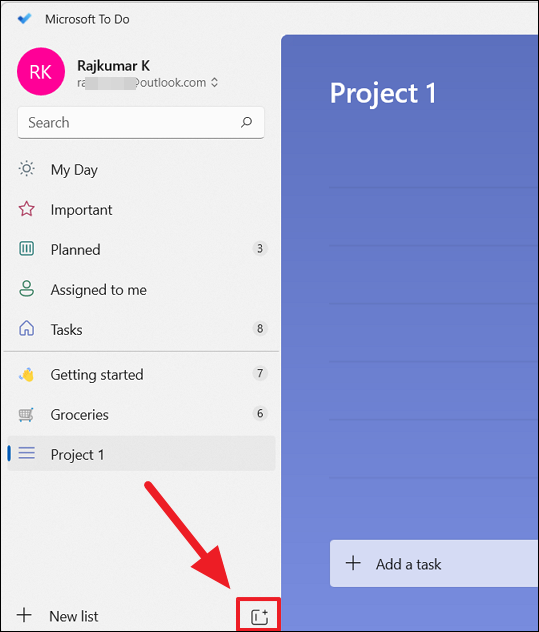
Step 2: Name the group by typing a new name and pressing Enter.
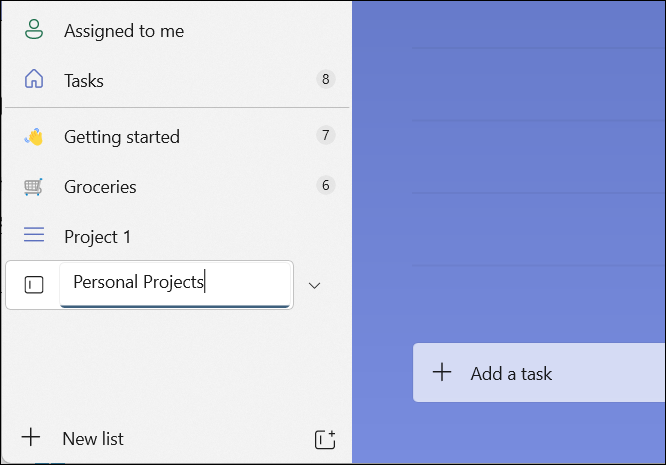
Step 3: To add lists to the group, drag and drop existing lists into the group or create new lists directly within the group.
Managing Tasks, Lists, and Groups
Efficient task management involves organizing and prioritizing your tasks, lists, and groups.
Managing Tasks
Customize your tasks using these features:
Step 1: Sort tasks by clicking the three dots at the top right corner of a list and selecting Sort by, then choose your preferred sorting method.

Step 2: Mark tasks as important by clicking the star icon next to the task or right-clicking and selecting Mark as important.
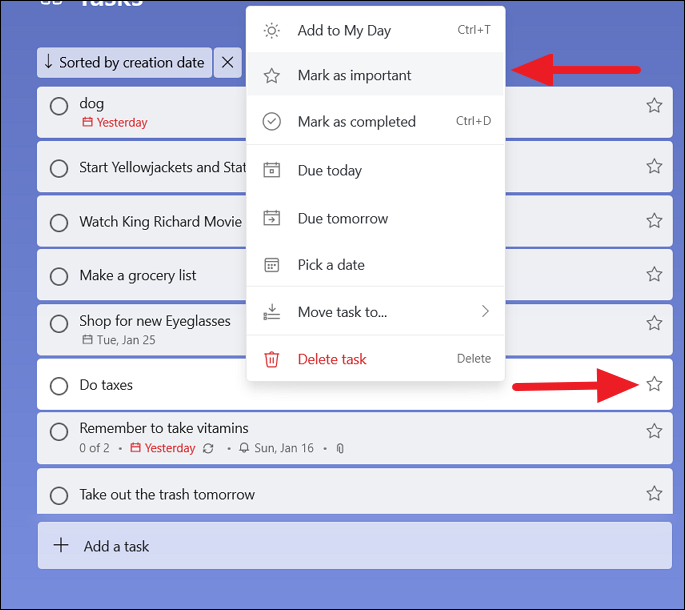
Step 3: Mark tasks as completed by checking the circle next to the task or right-clicking and selecting Mark as completed. Completed tasks move to the Completed list.
Managing Lists
Organize your lists to streamline your workflow:
Step 1: Rename a list by right-clicking it and selecting Rename or pressing F2.
Step 2: Add an emoji to your list by clicking on the list icon during the renaming process and selecting an emoji.
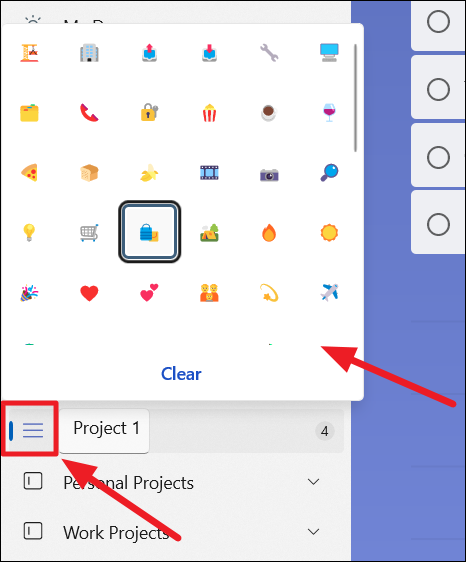
Step 3: Move a list to a group by right-clicking the list, selecting Move list to..., and choosing the desired group.
Sharing Tasks in Microsoft To Do
Collaborate with others by sharing your lists:
Step 1: Open the list you want to share and click the Share list icon or right-click the list and select Share list.
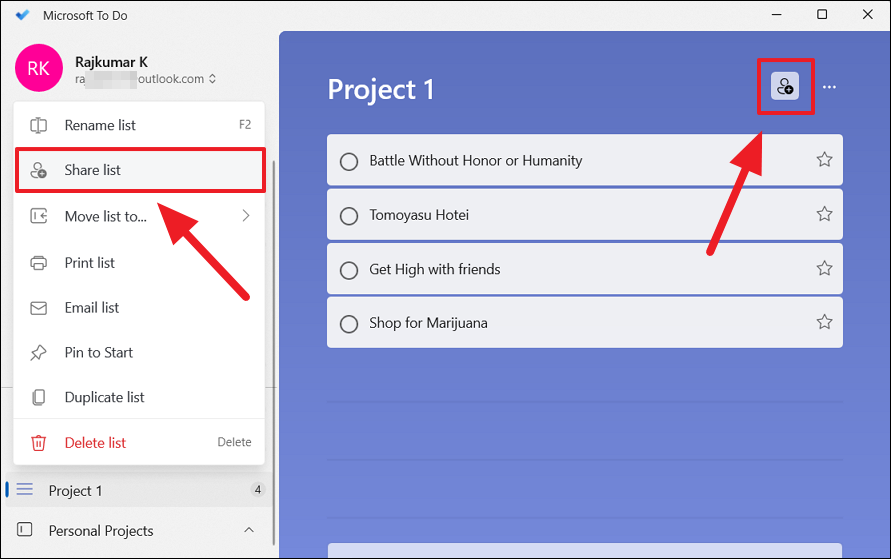
Step 2: Click on Create invitation link to generate a sharing link.

Step 3: Share the link via email by clicking Invite via email or copy the link to share through other platforms.
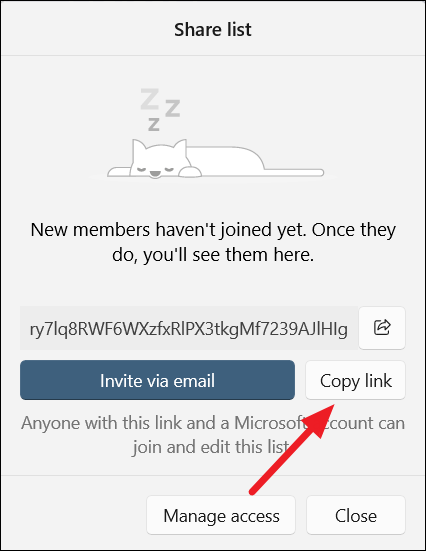
You can manage access or stop sharing the list in the Manage access section.
Microsoft To Do Keyboard Shortcuts
| Action | Keyboard Shortcut |
|---|---|
| Add a task | Ctrl+N |
| Create a new list | Ctrl+L |
| Add a task to My Day | Ctrl+T |
| Complete a task | Ctrl+D |
| Search | Ctrl+F |
| Sync | Ctrl+R |
Ctrl+P | |
| Toggle sidebar | Ctrl+1 |
| Paste files in task details | Ctrl+V |
Switch Accounts in Microsoft To Do
You can manage multiple accounts within the app:
Step 1: Click on your profile picture or name and select Manage accounts.
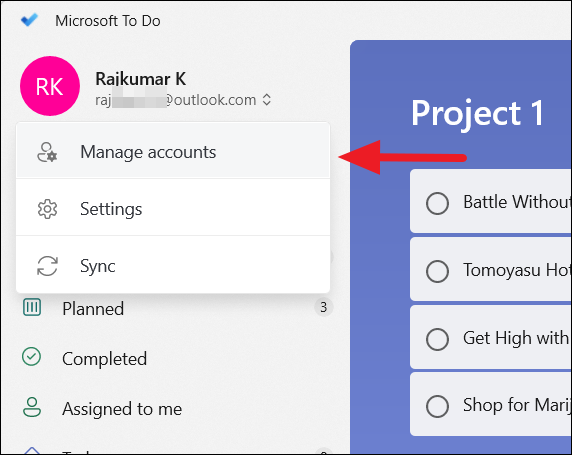
Step 2: Click on Add account and choose the account type.
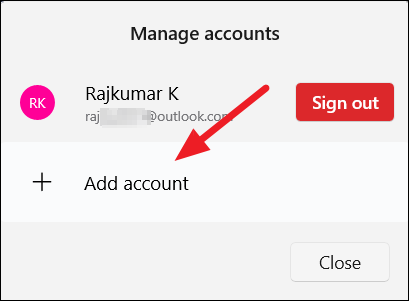
Step 3: Enter your credentials to add the account. You can switch between accounts by selecting the desired account from the Manage accounts menu.
Customize Themes in Microsoft To Do
Change App Theme
You can switch between light and dark themes:
Step 1: Click on your profile picture or name and select Settings.
Step 2: Under the Theme section, choose between Light, Dark, or Use my Windows theme.
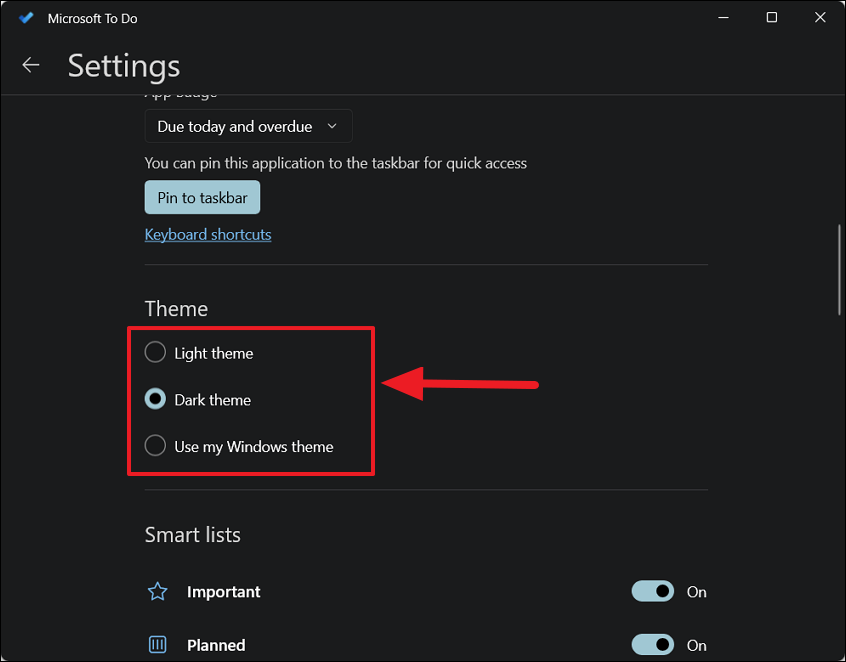
Change List Themes
Personalize individual lists with custom backgrounds:
Step 1: Open the list you want to customize.
Step 2: Click on the three dots at the top right corner and select a theme or background under Theme.
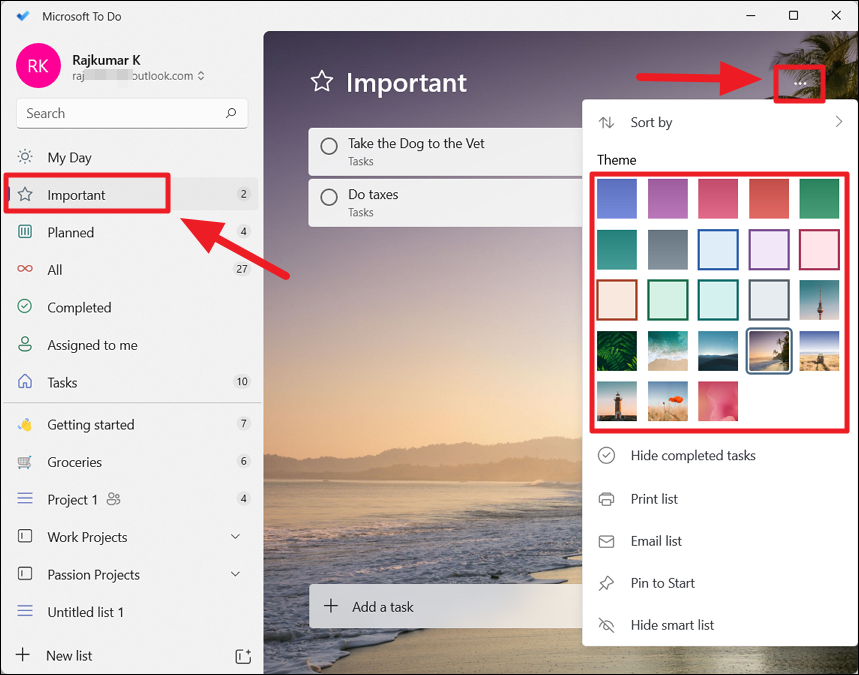
Utilize Suggestions to Manage Your Day
The My Day list offers personalized task suggestions:
Step 1: Open the My Day list.
Step 2: Click on the Light bulb icon at the top right to view suggested tasks based on your activity.

Enable or Disable Smart Lists
Customize which smart lists appear in your sidebar:
Step 1: Go to Settings by clicking your profile picture or name.
Step 2: Scroll to the Smart lists section and toggle the lists you want to show or hide.
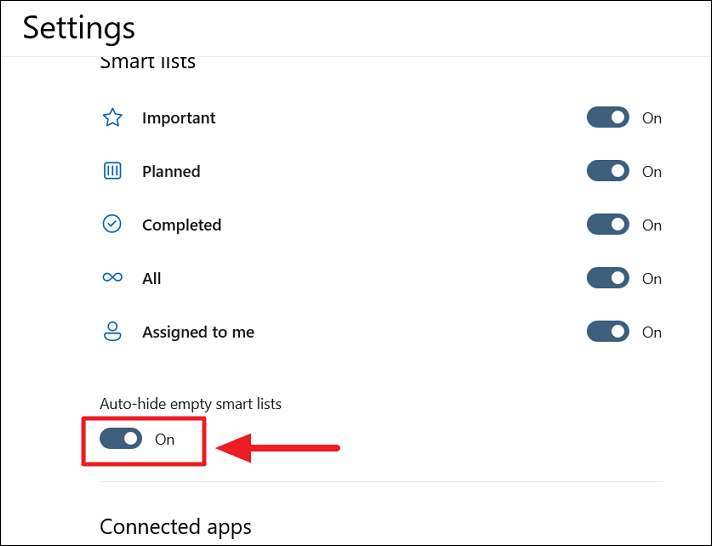
Handle Flagged Emails in Microsoft To Do
Integrate your Outlook emails with Microsoft To Do:
Step 1: In Outlook, flag an email by clicking the Flag icon next to it.

Step 2: The flagged email will appear in the Flagged email list in Microsoft To Do.
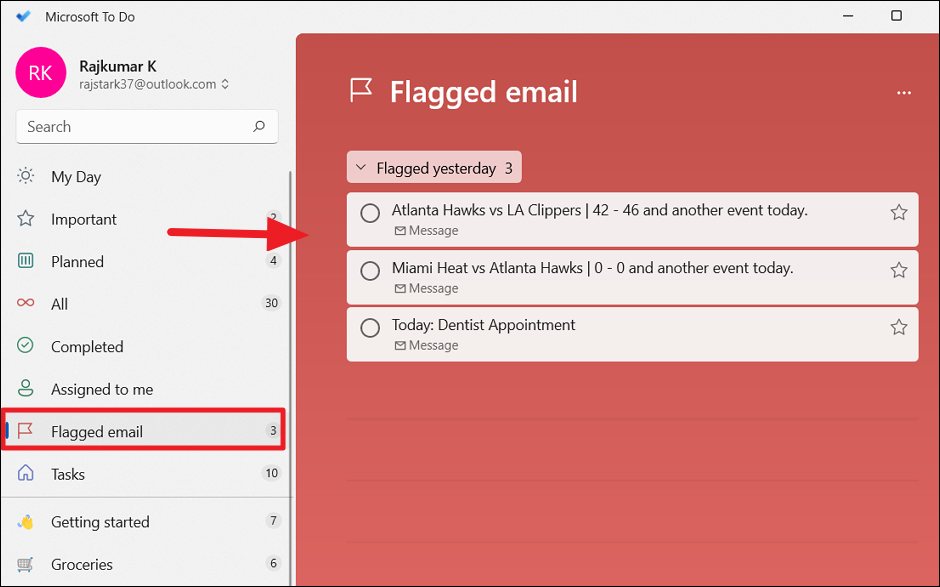
Create Tasks from Email in Microsoft To Do
You can convert emails into tasks directly from Outlook:
Step 1: Open Outlook and select the email you want to turn into a task.
Step 2: Drag and drop the email onto the Tasks icon at the bottom left.

Step 3: In the task window that opens, set the task details and click Save & Close.
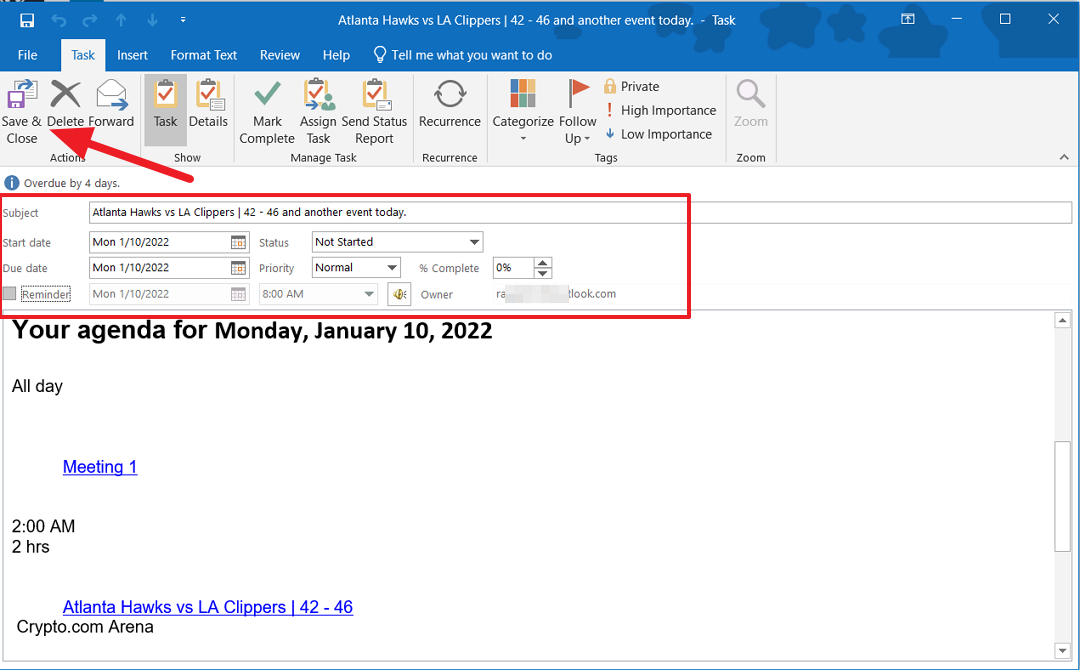
The task will now be available in Microsoft To Do under the Tasks list.
Add Hashtags to Your Tasks
Organize tasks using hashtags for easy searchability:
Step 1: Open a task and type a hashtag followed by a keyword in the Add note section, such as #work.

Step 2: Click the hashtag link or search for it to view all tasks tagged with that hashtag.
Plan Your Week with the Planned List
The Planned list helps you focus on upcoming tasks:
Step 1: Open the Planned list to see tasks categorized by date, such as Earlier, Today, and Later.
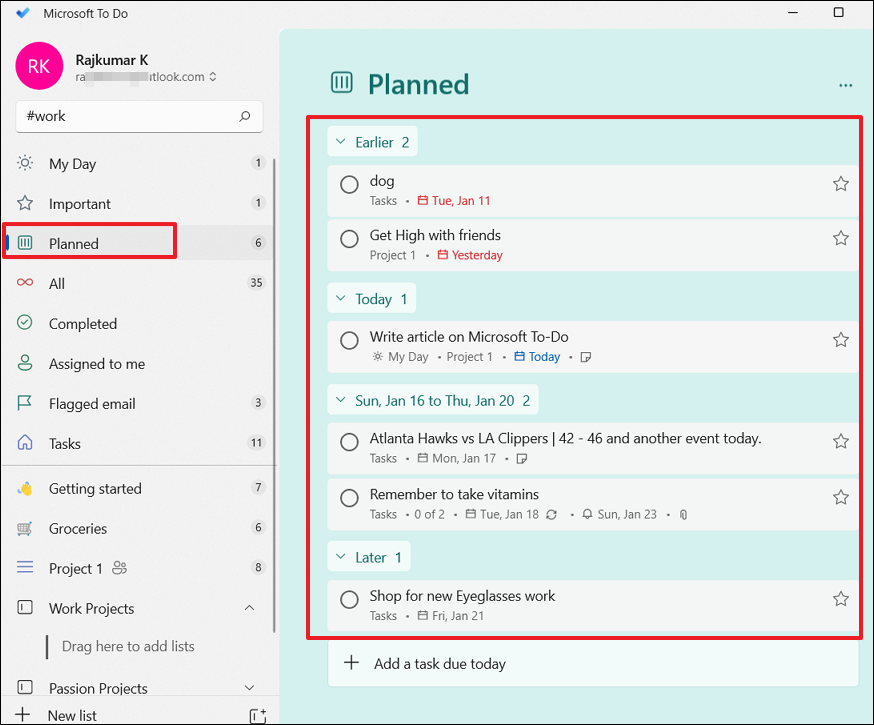
This view helps you prioritize tasks based on urgency and due dates.
Configure Advanced Settings in Microsoft To Do
Customize the app to suit your preferences:
Step 1: Go to Settings by clicking on your profile picture or name.
Step 2: Adjust settings under sections like General, Theme, and Notifications to personalize your experience.
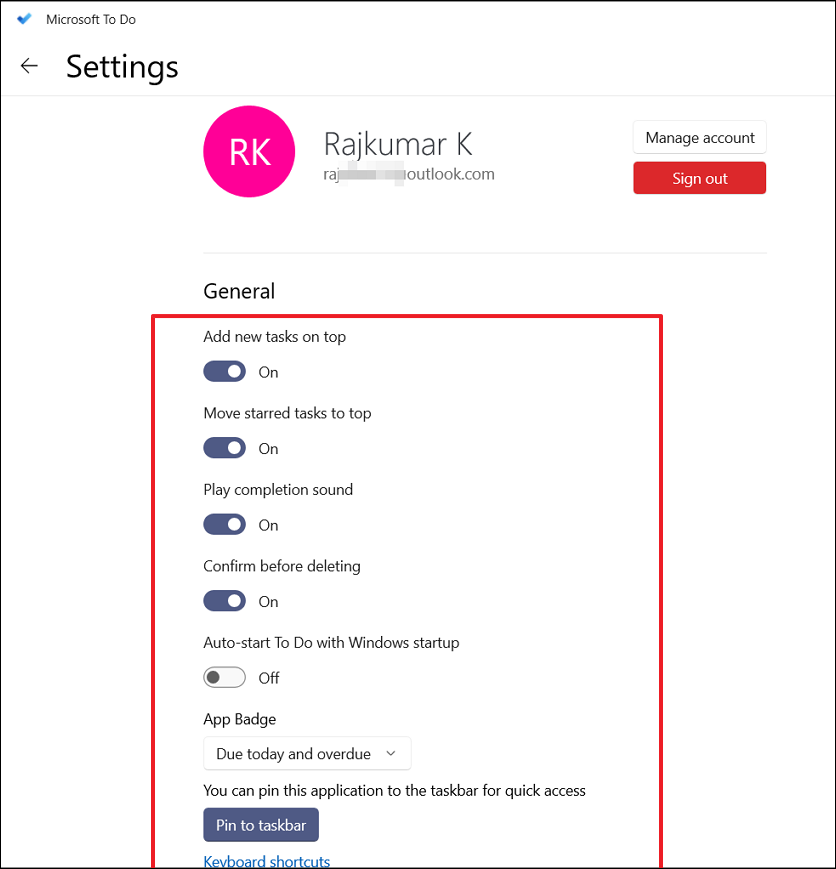
By mastering these features, you can enhance your productivity and stay organized with Microsoft To Do on Windows 11.

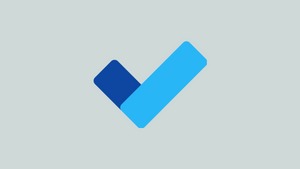









Member discussion